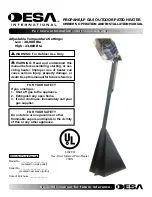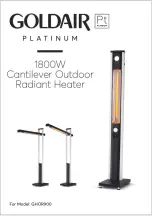
5
103427
SPLIT OAK AND AMERICAN OAK DESIGN
18", 24" AND 30" MODELS
AIR FOR
COMBUSTION AND
VENTILATION
Continued
4.
Compare the maximum Btu/Hr the
space can support with the actual
amount of Btu/Hr used.
________ Btu/Hr (maximum the
space can support)
________ Btu/Hr (actual amount of
Btu/Hr used)
Example:
51,200 Btu/Hr (maximum
the space can support)
73,000 Btu/Hr (actual
amount of Btu/Hr used)
The space in the above example is a con-
fined space because the actual Btu/Hr used
is more than the maximum Btu/Hr the space
can support. You must provide additional
fresh air. Your options are as follows:
A. Rework worksheet, adding the space of
an adjoining room. If the extra space
provides an unconfined space, remove
door to adjoining room or add ventila-
tion grills between rooms. See Ventila-
tion Air From Inside Building.
B. Vent room directly to the outdoors. See
Ventilation Air From Outdoors.
C. Install a lower Btu/Hr heater, if lower
Btu/Hr size makes room unconfined.
If the actual Btu/Hr used is less than the
maximum Btu/Hr the space can support, the
space is an unconfined space. You will need
no additional fresh air ventilation.
WARNING: If the area in which
the heater may be operated is
smaller than that defined as an
unconfined space, provide ad-
equate combustion and ventila-
tion air by one of the methods
described in the
National Fuel
Gas Code, ANSI Z223.1, 1992,
Section 5.3.
VENTILATION AIR
Ventilation Air From Inside Building
This fresh air would come from an adjoining unconfined space. When ventilating to an
adjoining unconfined space, you must provide two permanent openings: one within 12" of
the ceiling and one within 12" of the floor on the wall connecting the two spaces (see options
1 and 2, Figure 3). You can also remove door into adjoining room (see option 3, Figure 3).
Follow the National Fuel Gas Code NFPA 54/ANSI Z223.1, Section 5.3, Air for Combustion
and Ventilation for required size of ventilation grills or ducts.
Figure 4 - Ventilation Air from Outdoors
Ventilation Air From Outdoors
Provide extra fresh air by using ventilation grills or ducts. You must provide two permanent
openings: one within 12" of the ceiling and one within 12" of the floor. Connect these items
directly to the outdoors or spaces open to the outdoors. These spaces include attics and crawl
spaces.
IMPORTANT:
Do not provide openings for inlet or outlet air into attic if attic has a
thermostat-controlled power vent. Heated air entering the attic will activate the power vent.
Figure 3 - Ventilation Air from Inside Building
Outlet
Air
Ventilated
Attic
Outlet
Air
Inlet
Air
Inlet Air
Ventilated
Crawl Space
To
Crawl
Space
To Attic
Or
Remove
Door into
Adjoining
Room,
Option
3
Ventilation Grills
Into Adjoining Room,
Option 2
Ventilation
Grills
Into Adjoining
Room,
Option 1
12"
12"
WARNING: Rework worksheet, adding the space of the adjoining
unconfined space. The combined spaces must have enough fresh air to
supply all appliances in both spaces.






































